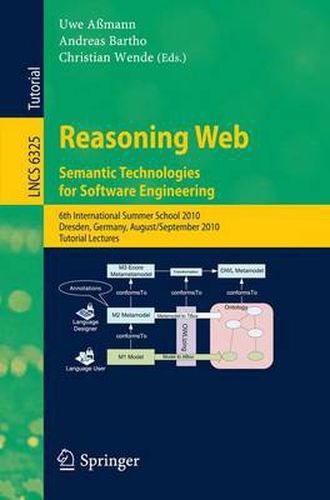Readings Newsletter
Become a Readings Member to make your shopping experience even easier.
Sign in or sign up for free!
You’re not far away from qualifying for FREE standard shipping within Australia
You’ve qualified for FREE standard shipping within Australia
The cart is loading…






Welcome to the proceedings of Reasoning Web 2010 which was held in Dresden. Reasoning Web is a summer school series on theoretical foundations,contemporary approaches, and practical solutions for reasoning in a Web of Semantics. It has est- lished itself as a meeting point for experts from research institutes and industry, as well as students undertakingtheir PhDs in related ?elds. This volume contains tutorial notes of the sixth school in the series, held from August 30 to September 3, 2010. This year, the school focused on applications of semantic technologies in software engineeringandthereasoningtechnologiesappropriateforsuchanendeavor. Asit turns out, semantic technologies in software engineering are not so easily applied, and s- eral issues mustbe resolvedbeforesoftware modelingcanbene?t fromreasoning. First, reasoning has to be fast and scalable, since models and programscan be quite large and voluminous. SincemanyreasoninglanguagesareexponentialorNP-complete,appro- mation, incrementalization,and other optimizationtechniques are extremelyimportant. Second, software engineering needs to model software systems, in contrast to mod- ing domains of the world. Thus, the modeling techniques are prescriptive rather than descriptive [1], which in?uences the way models are reasoned about. When a software system is modeled, its behavior is prescribed by the model, that is, the truth is in the model [2]; when a domainof the world is described,its behaviorcannotbe prescribed, only described by the model ( the truth is in the world ). Therefore, reasoning has to distinguish between prescriptiveness and descriptiveness, leading to different assu- tions about the closeness or openness of the world (closed-world assumption, CWA vs. open-world assumption, OWA).
$9.00 standard shipping within Australia
FREE standard shipping within Australia for orders over $100.00
Express & International shipping calculated at checkout
Welcome to the proceedings of Reasoning Web 2010 which was held in Dresden. Reasoning Web is a summer school series on theoretical foundations,contemporary approaches, and practical solutions for reasoning in a Web of Semantics. It has est- lished itself as a meeting point for experts from research institutes and industry, as well as students undertakingtheir PhDs in related ?elds. This volume contains tutorial notes of the sixth school in the series, held from August 30 to September 3, 2010. This year, the school focused on applications of semantic technologies in software engineeringandthereasoningtechnologiesappropriateforsuchanendeavor. Asit turns out, semantic technologies in software engineering are not so easily applied, and s- eral issues mustbe resolvedbeforesoftware modelingcanbene?t fromreasoning. First, reasoning has to be fast and scalable, since models and programscan be quite large and voluminous. SincemanyreasoninglanguagesareexponentialorNP-complete,appro- mation, incrementalization,and other optimizationtechniques are extremelyimportant. Second, software engineering needs to model software systems, in contrast to mod- ing domains of the world. Thus, the modeling techniques are prescriptive rather than descriptive [1], which in?uences the way models are reasoned about. When a software system is modeled, its behavior is prescribed by the model, that is, the truth is in the model [2]; when a domainof the world is described,its behaviorcannotbe prescribed, only described by the model ( the truth is in the world ). Therefore, reasoning has to distinguish between prescriptiveness and descriptiveness, leading to different assu- tions about the closeness or openness of the world (closed-world assumption, CWA vs. open-world assumption, OWA).